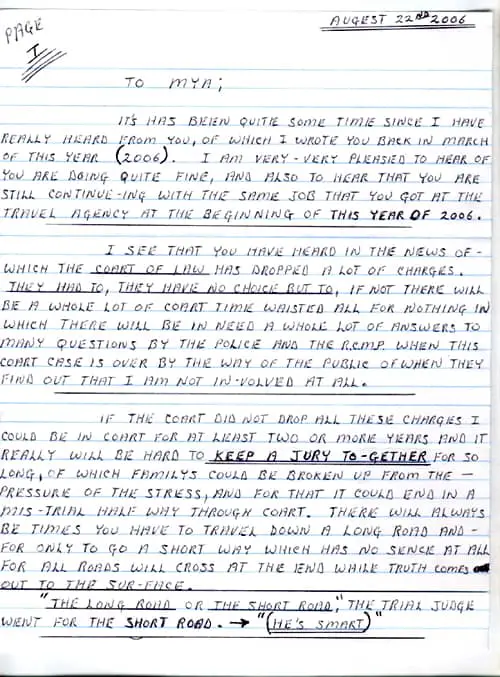1.2K
This is a guest post written by Laura Lewis. Please see her bio at the end of the post. Thank you, Laura for such a great post!
Robert Pickton – the case of the killer pig farmer
In 2007, the world was shocked and appalled by the revelations that came out of a small farm in Canada. Robert Pickton was arrested and charged with the murder of 26 women, but the murders were just the tip of the iceberg.
Background

Pickton was born in 1949 in Port Coquitlam, British Columbia, Canada. Not a great deal of information on Pickton’s early life is available to the public due to Canadian laws, but we know that pig farming has been in his family for three generations.
In 1992, Pickton and his brother David owned his family’s farm together. One of the people working for Pickton, Bill Hiscox, described Robert as a ‘pretty quiet guy, hard to strike up a conversation with,’ and sometimes exhibited bizarre behavior that would draw attention from people. Yet, there was no evidence that Pickton ever abused drugs.
The Pickton brothers eventually began neglecting the site’s farming operations, and in 1996, they registered a non-profit charity called The Piggy Palace Good Times Society with the Canadian Government. The Society was created to organize, coordinate and manage special events and functions for different organizations. What was occurring was raves and wild parties featuring prostitution, Hell’s Angels and many drugs.
In March 1997, Pickton was arrested and charged with the attempted murder of prostitute Wendy Lynn Eistetter. Wendy was stabbed several times during an altercation at the farm. Police later dropped the case as they felt that Wendy, a drug addict, would be an unreliable witness even though police found a key to the pair of handcuffs around Wendy’s wrists in the pocket of Robert Pickton.
Just two years later, the Canadian police received a tip that Robert kept human flesh in a freezer on his property. Although authorities secured a search warrant, they never searched.
The Murders
Over the next few years, Hiscox noticed that women who visited the farm were eventually listed as missing. On February 5th, 2002, police acted on a warrant for firearms charges when they found the missing women’s personal belongings. Pickton was immediately arrested, and officials obtained a second court order to allow police to continue their land search.
As police searched the farm, what they found was harrowing. Not only did Pickton take the lives of these women, but he also desecrated their bodies in horrendous ways. Police uncovered numerous victims’ remains, including skulls cut in half that had been stuffed with hands and feet. They also found the DNA of 33 women, a jawbone, numerous items of bloody women’s clothing, and women’s teeth.
Also recovered from the farm were a .22 revolver, .357 magnum rounds, two pairs of faux fur handcuffs, a pair of night-vision goggles, and photos of a garbage can containing what looked to be human remains.
The Victims
If I named all of Pickton’s victims, the list would be disturbingly long. His victims were female and between 20 and 50. Only a few were listed as missing, either by police or by their families, which suggests that some of the victims had fallen into a dangerous life.
Because Pickton’s case is still under investigation by Canadian police, there is little public information on his MO. According to a witness on tape, Pickton claimed that he brought prostitutes onto his farm, handcuffed and raped them, strangled them to death, then bled and gutted the victims as he would with his pigs. Some witnesses said that Pickton would accuse the victim of wronging him, so he could work himself up into a rage and commit the murder.
After his victims were dead, he ran their bodies through a wood chipper and fed the remains to his pigs. Another claim is that he would grind his victims up, mixing the human meat with pork mince from the farm and giving the produce to friends and family.
Another witness, Lynn Ellingsen, stated that she saw Pickton skinning a woman hanging from a meat hook. She said that she kept the information to herself out of fear for her life but admitted that she had blackmailed Pickton with this information on many occasions.

The Trial
Pickton’s trial began in January of 2006. He pleaded not guilty to 27 charges of first-degree murder. The ‘voir dire’ phase of the trial, during which evidence and witnesses are presented to the judge to ascertain their inadmissibility, took most of the year and finished with a huge shock.
Justice James Williams rejected one of the 27 murder counts for lack of evidence. He then split the remaining 26 charges into one group of six counts, leaving the remaining 20 for a separate trial. Justice Williams explained that trying the full 26 counts would put an unreasonable burden on the jury, resulting in the trial lasting for at least two years, at which point no one could rule out a mistrial. He also added that he chose to proceed with the first six counts as they were materially different from the other 20 in terms of evidence.
On December 9th, 2007, the jury returned with a verdict of not guilty on six counts of first-degree murder. Instead, they found him guilty on six counts of second-degree murder.
In Canada, a second-degree murder charge carries a sentence of life in prison with no possibility of parole between 10 and 25 years, as set by the judge. After reading 18 victim impact statements, Justice Williams sentenced Pickton to life with no parole for 25 years, the maximum possible sentence, and equal to the sentence for first-degree murder.
Pickton and his defense team later appealed this sentence, but a new trial was unanimously rejected by the Supreme Court of Canada’s Justices.
Officials later announced that the Crown Prosecution was discontinuing the other 20 charges against Pickton due to ‘the fact that any additional convictions could not result in any increase to the sentence Mr Pickton has already received’.

Life in Prison
In August of 2006, a 27-year-old aspiring journalist from California claimed that he had received three letters from Pickton in prison. The journalist, named Thomas Loudamy, is known for writing to famous prisoners under aliases that he thinks the prisoner will react positively to.
The letters from Pickton contained startling insights into his mind. They showed a clear case of what Jungian psychologists called a ‘Jehovah complex,’ as Pickton’s ramblings and rants about his victim’s ‘evil ways’ reflect the statements that he would work himself into a rage before he killed.
Today, Pickton remains in jail, and hopefully, will stay in his cell until the day he dies.
About the Author
Laura Lewis is a true crime enthusiast and a blogger. Her fascination with true crime began during her teens, when she read a journalistic account of the Fred and Rose West case. Her blog, lauloulew.wordpress.com covers a range of cases and she readily welcomes reader suggestions on cases they’d like to see covered.





























